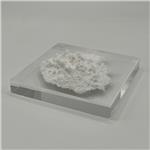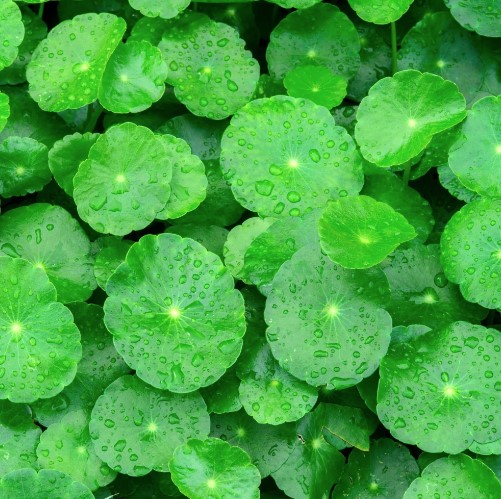Application research of Centella asiatica extract
Introduction
Centella asiatica extract (Figure 1) is a rich source of natural bioactive substances, triterpenoid saponins, flavonoids, phenolicacids, triterpenic steroids, amino acids and sugars. Centella asiatica is a medicinal plant belonging to the Apiaceae family commonly used as a traditional herbal medicine and major ingredient in nutraceutical products in Southeast Asian countries. Moreover, Centella asiatica is rich in the flavonoid quercetin, which has a therapeutic effect in the context of AD- induced by 2,4-dinitrochlorobenzene (DNCB). Centella asiatica is a pentacyclic triterpene-rich medicinal herb. The medicinal efficacy of the plant is mainly attributed to the most prominent bioactive triterpenes named madecassoside (MO), asiaticoside (AO), madecassic acid (MA), and asiatic acid (AA). The distribution of pentacyclic triterpenes accumulated in the plant varies according to plant parts, cultivation zone, and harvesting period . Centella asiatica and its triterpenes have been reported to exhibit wound healing and memory improvement properties, and improve the treatment of asthma, psoriasis, ulcer, and cancer. In addition, Centella asiatica and its active triterpenes constituents have been proved to act as an anti-allergic, anti-inflammatory, antifibrotic, cardioprotective, neuroprotective, antioxidant, antidepressant, anticancer, antibacterial, and antifungal agent.[1]

Application research
1.Moisturizing and Antiinflammatory Properties of Cosmetic Formulations Containing Centella asiatica Extract
The aim of the present study was to evaluate the in vivo moisturizing and antiinflammatory properties of cosmetic formulations (oil-in-water emulsioncream and hydrogel) containing different concentrations of Centella asiatica extract. The study was conducted over four weeks on a group of 25 volunteers after twice a day application of cosmetic formulations with Centella asiatica extract (2.5 and 5%, w/w) on their forearms. The measurement of basic skin parameters (stratum corneum hydration and epidermal barrier function) was performed once a week. The in vivo antiinflammatory activity based on the methyl nicotinate model of microinflammation in human skin was evaluated after four weeks application of tested formulations. In vivo tests formulations containing 5% of Centella asiatica extract showed the best efficacy in improving skin moisture by increase of skin surface hydration state and decrease in transepidermal water loss as well as exhibited antiinflammatory properties based on the methyl nicotinate model of microinflammation inhuman skin. Comparative tests conducted by corneometer, tewameter and chromameter showed that cosmetic formulations containing Centella asiatica extract have the moisturizing and antiinflammatory properties. The active substances contained in Centella asiatica extract, especially saponins, flavonoids and phenolicacid showing antioxidant and antiinflammatory activity, could affect on the reduction of the erythema and also help to improve the skin barrier function (decrease in TEWL and pH value), which is associated with the fast skin return to homeostasis after exposure on irritants. As previous in vitro studies have shown saponins from Centella asiatica extract have the ability to chelate metal ions, this property is also associated with the ability of saponins to inhibit the activity of enzymes by the formation of complexes with metals that present in the active centre and also by binding through sigma bonds of the compounds that are cofactors for enzymes. Also flavonoids and phenolic compounds from Centella asiatica extract have been shown to possess antilipoxygenase and antioxidant activities. Therefore, the topical application of cosmetic formulations containing Centella asiatica extract can be suggested as a possible strategy to prevent and modulate oxidative skin damages. The results showed that the emulsion and hydrogel with Centella asiatica extract was able to decrease, to a statistically significant extent (P<0.05), the skin redness, TEWL and pH value in comparison to the control area and placebo.
Formulations containing different concentrations of Centella asiatica extract showed efficacy in improving skin moisture by increase of skin surface hydration state and decrease in transepidermal water loss (TEWL) as well as antiinflammatory properties based on the methyl nicotinate model of microinflammation in human skin. On the basis of the obtained results it may be concluded that cosmetic formulations containing Centella asiatica extract have the moisturizing and antiinflammatory properties. Centella asiatica extract is an effective ingredient not only in antiaging cosmetics but also for improving skin hydration. [2]
2.Centella asiatica extract protects against cisplatin-induced hepatotoxicity via targeting oxidative stress, inflammation, and apoptosis.
Centella asiatica extract, due to its low cost, easy accessibility, and nontoxicity, has been clinically investigated in various fields. Many preclinical and clinical studies have demonstrated its effectiveness in other diseases. Moreover, it is widely used in the treatment of vascular diseases such as venous hypertensive microangiopathy, diabetic microangiopathy ,and chronic venous insufciency.Clinical trials have also been conducted for other conditions such as leprosy and chronic liver disorder. This study was designed to investigate the protective effects of centella asiatica extract on cisplatin-induced hepatotoxicityand to clarify the underlying mechanism by biochemical, molecular, immunohistochemical, and histopathological analyses. Rats were pre-treated with two doses of centella asiatica extract (100 and 200 mg/kg, p.o.) for 14 consecutive days. Then, on the 15th day,hepatotoxicity was induced by a single cisplatin injection (10mg/kg i.p.). On the 18th day, the rats were euthanized. Centella asiatica extract effectively alleviated cisplatin-induced hepatic injury via reduction in AST, ALT, and ALP enzymes and a decrease in oxidative stress (decreased MDA and ROS, and increased SOD, CAT, and GSH). Centella asiatica extract also mitigated the inflammatory damage by the inhibition of TNF-α, IL-1β, and NF-κB. The liver expression of caspase-3 and Bax was downregulated, while Bcl-2was upregulated. Moreover, immunohistochemical results confirmed the recovery with centella asiatica extract by downregulation of iNOS and 8-OHdG expression. These results showed that with its antioxidant, anti-inflammatory, and anti-apoptotic activities, centella asiatica extract could help alleviate the hepatotoxic effects of cisplatin chemotherapy.[3]
References
[1]Lee Y, Choi HK, N'deh KPU, et al. Inhibitory Effect of Centella asiatica Extract on DNCB-Induced Atopic Dermatitis in HaCaT Cells and BALB/c Mice. Nutrients. 2020;12(2):411. Published 2020 Feb 5. doi:10.3390/nu12020411
[2]Ratz-Łyko A, Arct J, Pytkowska K. Moisturizing and Antiinflammatory Properties of Cosmetic Formulations Containing Centella asiatica Extract. Indian J Pharm Sci. 2016;78(1):27-33. doi:10.4103/0250-474x.180247
[3]Ferah Okkay I, Okkay U, Aydin IC, et al. Centella asiatica extract protects against cisplatin-induced hepatotoxicity via targeting oxidative stress, inflammation, and apoptosis. Environ Sci Pollut Res Int. 2022;29(22):33774-33784. doi:10.1007/s11356-022-18626-z
You may like
Related articles And Qustion
See also
Lastest Price from Centella asiatica extract manufacturers

US $5.00-0.50/KG2025-05-08
- CAS:
- 84696-21-9
- Min. Order:
- 1KG
- Purity:
- 99% hplc
- Supply Ability:
- 500TONS

US $0.00-0.00/kg2025-04-21
- CAS:
- Min. Order:
- 1kg
- Purity:
- 20% - 95% Centellosides
- Supply Ability:
- 1 ton



